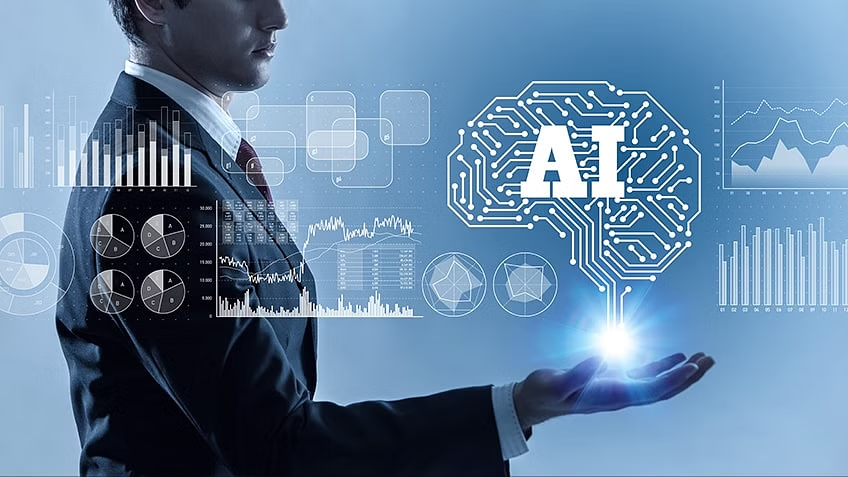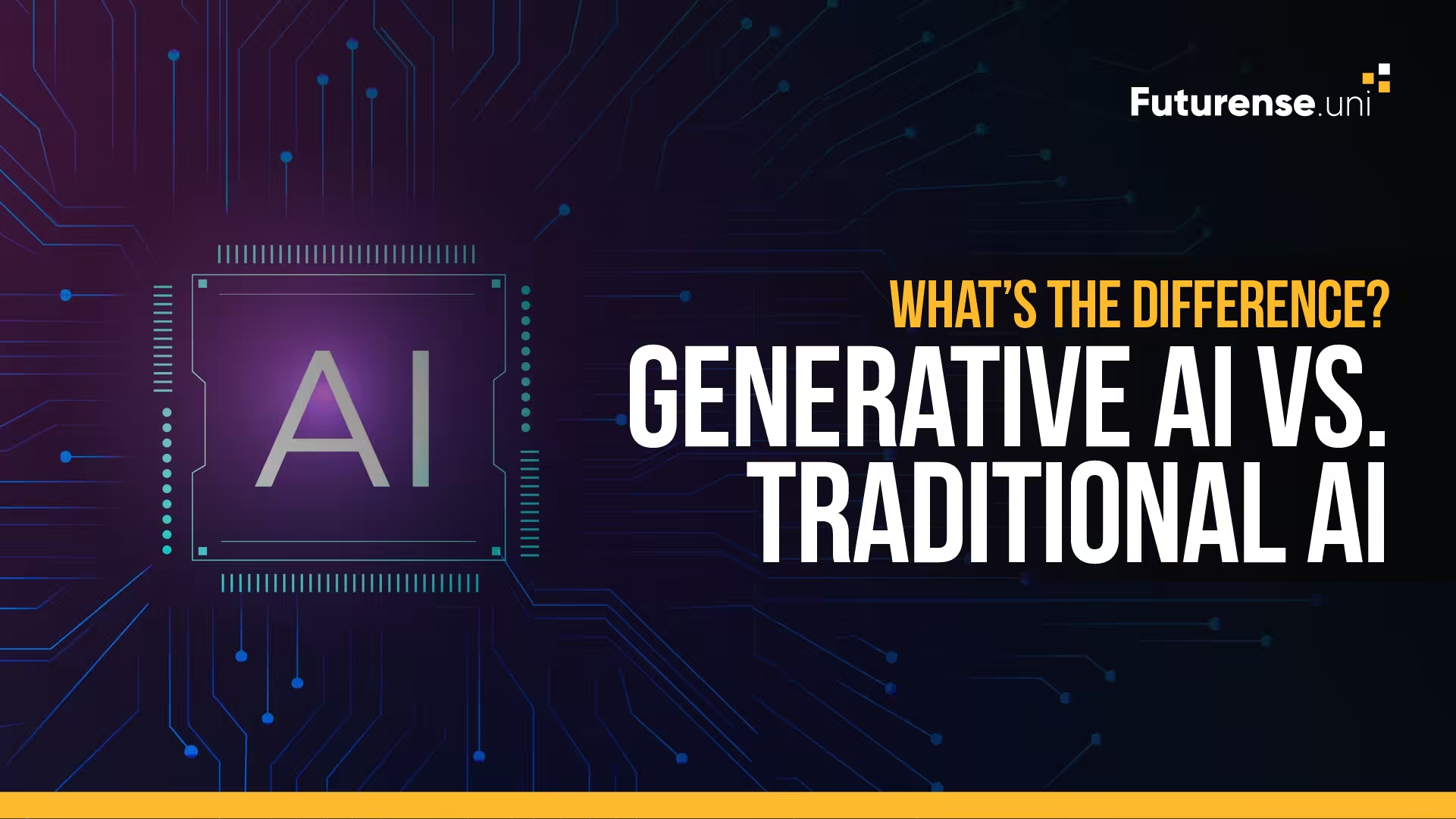Artificial Intelligence (AI) has revolutionized the way we interact with technology, solve problems, and create innovative solutions. Over the years, AI has evolved from rule-based systems to advanced models capable of generating human-like content.
Two major branches of AI that have gained significant attention are Traditional AI and Generative AI. While Traditional AI focuses on analyzing data and making predictions, Generative AI is designed to create new content, such as text, images, and music. Understanding the differences between these two is crucial for anyone looking to explore the field of AI, whether through best gen AI courses online or pursuing a gen AI masters degree online.
This article delves into the core concepts, applications, and differences between Generative AI and Traditional AI, helping you decide which path to take in your AI journey.
What is Traditional AI?
Traditional AI, also known as Narrow AI, refers to systems designed to perform specific tasks by analyzing data and identifying patterns. It relies on predefined rules and algorithms to make decisions or predictions. Traditional AI encompasses technologies like machine learning, natural language processing (NLP), and computer vision.
1: Key Technologies and Methodologies
- Rule-based systems: These systems follow a set of predefined rules to make decisions.
- Machine learning: Includes supervised, unsupervised, and reinforcement learning, where models learn from data to make predictions or classifications.
2: Applications of Traditional AI
- Predictive analytics: Used in finance for stock market predictions.
- Natural Language Processing (NLP): Powers chatbots and language translation tools.
- Computer vision: Enables facial recognition and object detection.
3: Strengths and Limitations
- Strengths: High accuracy in specific tasks, interpretability, and reliability.
- Limitations: Limited to predefined tasks, requires large labeled datasets, and lacks creativity.
Also Read: Cybersecurity: Protecting Your Digital World
What is Generative AI?
Generative AI is a subset of AI that focuses on creating new content, such as text, images, music, and even videos. Unlike Traditional AI, which analyzes existing data, Generative AI generates new data that mimics human creativity. This is achieved through advanced models like Generative Adversarial Networks (GANs) and transformers.
1: Key Technologies and Methodologies
- Generative Adversarial Networks (GANs): Two neural networks (generator and discriminator) work together to create realistic data.
- Variational Autoencoders (VAEs): Used for generating new data points similar to the training data.
- Transformer models: Examples include GPT (Generative Pre-trained Transformer) and BERT, which are used for text generation and understanding.
2: Applications of Generative AI
- Content creation: Writing articles, creating art, and composing music.
- Data augmentation: Generating synthetic data for training machine learning models.
- Simulation and modeling: Creating virtual environments for testing and training.
3: Strengths and Limitations
- Strengths: High creativity, ability to generate new content, and versatility.
- Limitations: High computational requirements, potential for misuse (e.g., deepfakes), and ethical concerns.
Also Read: MAANG Companies: Who are These Tech Giants?
Key Differences Between Generative AI and Traditional AI
Understanding the differences between Generative AI and Traditional AI is essential for choosing the right tools and techniques for your projects.
1: Objective and Functionality:
- Traditional AI: Focuses on pattern recognition, prediction, and classification.
- Generative AI: Aims to create new content and generate data.
2: Data Requirements:
- Traditional AI: Requires large labeled datasets for training.
- Generative AI: Can work with unlabeled data and generates new data.
3: Complexity and Computational Requirements:
- Traditional AI: Generally less complex and requires moderate computational power.
- Generative AI: Highly complex and demands significant computational resources.
4: Output and Use Cases:
- Traditional AI: Used for decision-making, automation, and analysis.
- Generative AI: Applied in creative tasks, content generation, and simulations.
Technological Underpinnings
Both Traditional AI and Generative AI rely on different technologies and architectures.
1: Traditional AI
- Algorithms: Decision trees, support vector machines, and neural networks.
- Training: Supervised, unsupervised, and reinforcement learning.
2: Generative AI
- Architectures: GANs, VAEs, and transformers.
- Training: Adversarial training, self-supervised learning.
Applications and Use Cases
Both types of AI have unique applications across industries.
1: Traditional AI
- Healthcare: Diagnostics and treatment recommendations.
- Finance: Fraud detection and risk assessment.
- Retail: Customer segmentation and inventory management.
2: Generative AI:
- Entertainment: Movie scriptwriting and game design.
- Marketing: Personalized content creation and ad design.
- Healthcare: Drug discovery and medical imaging.
Challenges and Ethical Considerations
Both Traditional AI and Generative AI face challenges and ethical concerns.
1: Traditional AI
- Bias in training data.
- Lack of interpretability and transparency.
2: Generative AI
- Deepfakes and misinformation.
- Intellectual property issues.
3: Common Challenges
- Data privacy concerns.
- Ethical use of AI technologies.
Future Trends and Developments
The future of AI lies in the evolution and convergence of Traditional AI and Generative AI.
1: Traditional AI
- Integration with IoT and blockchain.
- Enhanced interpretability and fairness.
2: Generative AI
- Improved realism and quality of generated content.
- Broader adoption across industries.
3: Convergence
- Hybrid models combining the strengths of both AI types.
Conclusion
Generative AI and Traditional AI serve different purposes but are equally important in the AI ecosystem. Whether you’re interested in taking the best gen AI courses online or pursuing a gen AI masters degree online, understanding these technologies will help you make informed decisions. For beginners, exploring the best gen AI courses for beginners is a great starting point, while advanced learners might consider a generative AI course or the best gen artificial intelligence course to deepen their knowledge.
At Futurense, we are committed to empowering learners with cutting-edge programs like the PG Certificate Program in GenAI/Agentic AI and ML Applications for Engineers, designed to equip engineers with the skills needed to excel in the evolving AI landscape. Additionally, check out our Futurense UNI and Futurense USP program offers specialized courses tailored to industry demands, and the ensures a holistic learning experience by combining technical expertise with practical applications.
FAQs
What is Traditional AI?
Traditional AI (Narrow AI) follows predefined rules to analyze data, make predictions, and automate tasks. It powers applications like fraud detection, recommendation systems, and voice assistants.
What is Generative AI?
Generative AI creates new content—text, images, or code—by learning patterns from data. Examples include ChatGPT, DALL·E, and AI-generated music and design.
Can Generative AI Replace Traditional AI?
No. They serve different purposes. Traditional AI is ideal for structured tasks like automation, while Generative AI excels in content creation and design.
Applications of Traditional AI?
Used in fraud detection, recommendation systems, predictive maintenance, spam filtering, and voice assistants.
Applications of Generative AI?
Used for content creation, AI-powered design, code generation, marketing, and AI-driven simulations.

.avif)







.avif)